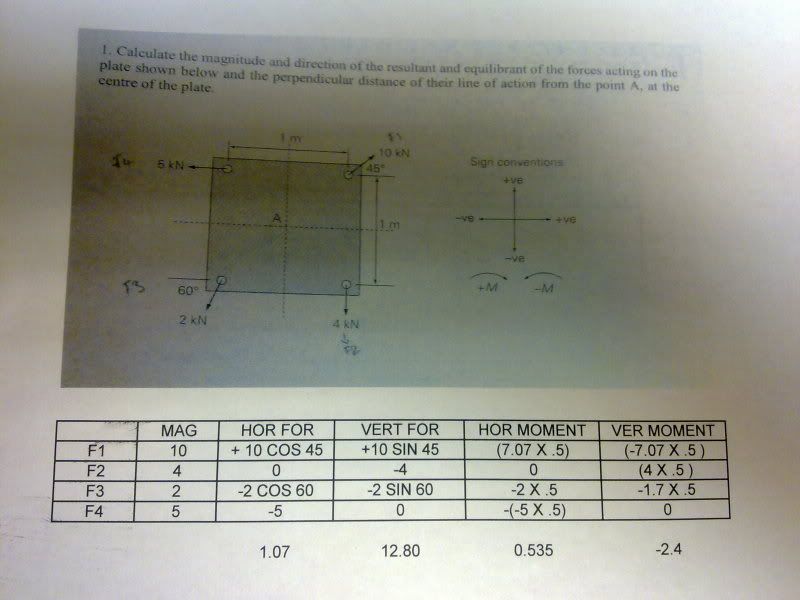 |
|
| Browse | Ask | Answer | Search | Join/Login |
|
|
||||
|
Magnitude and direction of the resultant and equilibrant of the forces acting on
Magnitude and direction of the resultant and equilibrant of the forces acting on the plate.
Not sure where to start with this can somebody please help? Thanks Phatone |
||||
|
|
|
||||
|
1. Make a sketch with the relevant angles. 2. Since the number of forces acting on the plate is not explicit, I'll advise finding the components of each force along an arbitrary horizontal and vertical axis. 3. Find the resultant force long the vertical and the horizontal. 4. Use vector addition to add the two forces to get the resultant magnitude of the forces. 5. Use appropriate trigonometric ratio such as the tangent ratio to get the angle of the resultant force. |
||||
|
|
|
||||
|
Here is what I have got so far...
MAG HOR FOR VERT FOR HOR MOMENT VER MOMENT F1 10 + 10 COS 45 +10 SIN 45 (7.07 X .5) (-7.07 X .5 ) F2 4 0 -4 0 (4 X .5 ) F3 2 -2 COS 60 -2 SIN 60 -2 X .5 -1.7 X .5 F4 5 -5 0 -(-5 X .5) 0 |
||||
|
|
|
||||
|
Um... are you dealing with moments?
By plate, I assumed that a plate was being pushed/pulled by forces, but now that you mention horizontal moment :confused: If the situation is like a plate on a flat table being pulled by 4 forces, you add each force in the horizontal direction and each force in the vertical direction. And I have absolutely no idea where the 0.5 comes from... |
||||
|
|
|
||||
|
The 0.5 is the centre point on the plate. I attached a diagram on my first email not sure where it is now though??
|
||||
|
|
|
||||
|
No, the diagram is not there... =/ Do you have the link to the picture? |
||||
|
|
|
||||
|
Magnitude and direction
Ok here is what I have so far can you please comment..
Thanks |
||||
|
|
|
||||
|
Lol, okay, the link is this :)  And the question is sure clearer :) Okay, use the table you were given. The total moment is given by: I only followed the signs given to me that is clockwise is +ve and anticlockwise negative. Now for the translational motion... Direction is: |
||||
|
|
|
||||
|
Brill thanks for the end working outs.
Please could you check the information in the table has I have had to work it out by just using the diagram above... Thnaks.. Phats |
||||
|
|
|
||||
|
You made the table? No wonder I had trouble with the moments... :o Well, the forces are good, but not the moments. When it comes to moments, don't take the direction of the force you initially took for the Horizontal and Vertical force. Just follow the clockwise/anticlockwise direction set to put in the magnitudes. In the table, I would rather put 'clockwise' or 'c/w' moment and 'anticlockwise' or 'a/w' instead of horizontal and vertical moments. And you'll see that for F3, Horizontal moment is positive, F4, Horizontal moment is negative. |
||||
|
|
| Question Tools | Search this Question |
Check out some similar questions!
The force of 5N and a force of 8 N act at the same point and inclined at 45deg. To each other. Find the magnitude and direction of the resultant force. Explain how a parallelograme of law of force may be applied to velocities.
I have a question which requires finding the magnitude and direction of a resultant force (including angles as to be able to accurately draw on paper). The question is written as follows: "consider two forces, F1 and F2, of magnitudes 17N and 9N respectively, acting on a particle (diagram). what...
A grasshopper makes four jumps. The displacement vectors are (1) 27.0 cm, due west; (2) 23.0 cm, 35.0° south of west; (3) 28.0 cm, 55.0° south of east; and (4) 35.0 cm, 63.0° north of east. Find the magnitude and direction of the resultant displacement. Express the direction with respect to due...
sorry I forgot to put the values for the angl Q :mad: All angls are measured anti clockwise from the x a-axis F1=60N, F2=45N,F3=25N, F4=15N Q1=30, Q2=120,Q3=220, Q4=320
I am in a high school physics course and NEED some help with this problem. Four forces act on a hot-sir balloon, Force upward= 5120N Force downward= 4050N Force westward= 1520N Force eastward= 950N Find the magnitude and direction of the resultant force...
View more questions Search
|





